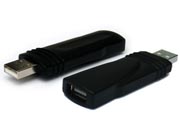Taking care of your storage media
 Berlin - Whether you prefer DVDs or USB sticks, storage media today function as our digital memory. But "all storage media is intended for a limited lifespan," notes Peter Knaak, technology expert at the German consumer testing organisation Stiftung Warentest in Berlin. Optical storage media like CDs, DVDs, or Blu-Ray disks can be kept for up to 50 years, the manufacturers claim, while hard drives and flash storage like USB sticks or memory cards can be expected to last 10 years. Careful handling is also crucial to extending that service life.
Berlin - Whether you prefer DVDs or USB sticks, storage media today function as our digital memory. But "all storage media is intended for a limited lifespan," notes Peter Knaak, technology expert at the German consumer testing organisation Stiftung Warentest in Berlin. Optical storage media like CDs, DVDs, or Blu-Ray disks can be kept for up to 50 years, the manufacturers claim, while hard drives and flash storage like USB sticks or memory cards can be expected to last 10 years. Careful handling is also crucial to extending that service life.
The factors contributing to the life span of storage media include the choice of storage location, the climate there and how carefully the media is handled. Hard drives, for example, are mechanical products with mobile parts which are subject to natural wear and tear. They should never be dropped or moved when operating.
That makes hard drives unsuitable for long-term archiving. "They must be regularly plugged in and run briefly; otherwise, the fluid in the bearings can dry out," says Karl Froehlich from the online magazine speicherguide. de. Small drops are less relevant for USB sticks and storage cards, which are principally electronics on the inside. Both types of storage are threatened by fluids, high levels of humidity in the air, and strong electromagnetic fields.
The primary culprit behind lost data on flash storage medium is not technical at all, says storage media maker Verbatim. "Users often aren't patient enough to wait for the storage process to finish. They then pull the stick or card out of the computer too soon," says Verbatim's Maria Csilics.
Optical storage media like CDs and DVDs are still as popular as ever, but require the same degree of care. Ultraviolet light can damage the discs severely.
"It can lead to the decomposition of the sensitive layer within with data is stored," explains Maria Csilics. Strong temperature swings can also bend the storage media. The best results are achieved by storing the disks vertically in a dry dark place using standard, commercially available plastic cases.
Stick-on labels can make home burned CDs and DVDs look nicer, but temperature swings can cause them to expand or contract-warping the disc in the process. The best way to improve the appearance of a disc is using LightScribe, a technology where the burner adorn the blanks directly.
"Those kind of drives are no longer significantly more expensive," Froehlich notes. Permanent markers should only be used if they contain no solvents.
Sweat from the user's hand is also bad for the discs. The proper way to hold a CD or DVD is to hold it on its edges and through the centre hole. Cleaning should only be done with a lint-free microfibre cloth.
It also makes sense to buy higher quality media: "More expensive products with a scratch-proof coating generally last longer," says Knaak from Stiftung Warentest. (dpa)